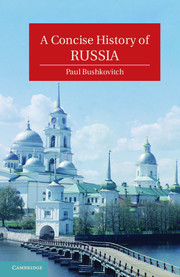Book contents
- Frontmatter
- Contents
- List of Figures
- Abbreviations
- Acknowledgments
- Prologue
- 1 Russia before Russia
- 2 Moscow, Novgorod, Lithuania, and the Mongols
- 3 The Emergence of Russia
- 4 Consolidation and Revolt
- 5 Peter the Great
- 6 Two Empresses
- 7 Catherine the Great
- 8 Russia in the Age of Revolution
- 9 The Pinnacle of Autocracy
- 10 Culture and Autocracy
- 11 The Era of the Great Reforms
- 12 From Serfdom to Nascent Capitalism
- 13 The Golden Age of Russian Culture
- 14 Russia as an Empire
- 15 Autocracy in Decline
- 16 War and Revolution
- 17 Compromise and Preparation
- 18 Revolutions in Russian Culture
- 19 Building Utopia
- 20 War
- 21 Growth, Consolidation, and Stagnation
- 22 Soviet Culture
- 23 The Cold War
- Epilogue
- Further Reading
- Index
7 - Catherine the Great
Published online by Cambridge University Press: 05 June 2012
- Frontmatter
- Contents
- List of Figures
- Abbreviations
- Acknowledgments
- Prologue
- 1 Russia before Russia
- 2 Moscow, Novgorod, Lithuania, and the Mongols
- 3 The Emergence of Russia
- 4 Consolidation and Revolt
- 5 Peter the Great
- 6 Two Empresses
- 7 Catherine the Great
- 8 Russia in the Age of Revolution
- 9 The Pinnacle of Autocracy
- 10 Culture and Autocracy
- 11 The Era of the Great Reforms
- 12 From Serfdom to Nascent Capitalism
- 13 The Golden Age of Russian Culture
- 14 Russia as an Empire
- 15 Autocracy in Decline
- 16 War and Revolution
- 17 Compromise and Preparation
- 18 Revolutions in Russian Culture
- 19 Building Utopia
- 20 War
- 21 Growth, Consolidation, and Stagnation
- 22 Soviet Culture
- 23 The Cold War
- Epilogue
- Further Reading
- Index
Summary
Catherine's first task on ascending the throne was to secure her power and deal with the unfinished business of her husband's reign. She quickly confirmed his decree abolishing compulsory service for the nobility, but she delayed the decree confiscating monastery lands. She had proclaimed herself the defender of Russian interests and of Orthodoxy, and she knew that the church was not happy with the move. Furthermore count Panin had plans to reorganize the central government around a state council that would have some sort of power alongside the monarch. The new empress, after a delay of more than a year, and after deposing the obstreperous and very rich bishop of Rostov, decreed the secularization of church lands in 1764. Nearly a fifth of the Russian peasantry ceased to be serfs. Regarding Panin's plans she was more cautious, merely ignoring them and keeping him to head the College of Foreign Affairs and supervise the education of her son and heir Paul.
Foreign policy demanded Catherine's attention for much of the first decade of her reign, even though she had been preoccupied with notions of reform of state and society from the time of her reading of Montesquieu and others in the 1750s. Unfortunately, Catherine could not control events and in the autumn of 1763 the king of Poland died. His death created a serious problem and Catherine had to act. From the last years of the Northern War, Poland, the onetime great power of Eastern Europe, had succumbed to a declining economy and population and an anarchic constitution. It had a weak elected king, all-powerful magnates, and a diet of nobles whose main aim was the conservation of traditional law and privileges above all else. Its neighbors, Prussia, Austria, and especially Russia liked this situation, and however absolute at home, their rulers were intent on preserving the “Golden Freedom” of the Polish nobility. A weak Poland with a tiny army suited them all and their ambassadors directed the Polish state.
- Type
- Chapter
- Information
- A Concise History of Russia , pp. 117 - 137Publisher: Cambridge University PressPrint publication year: 2011

